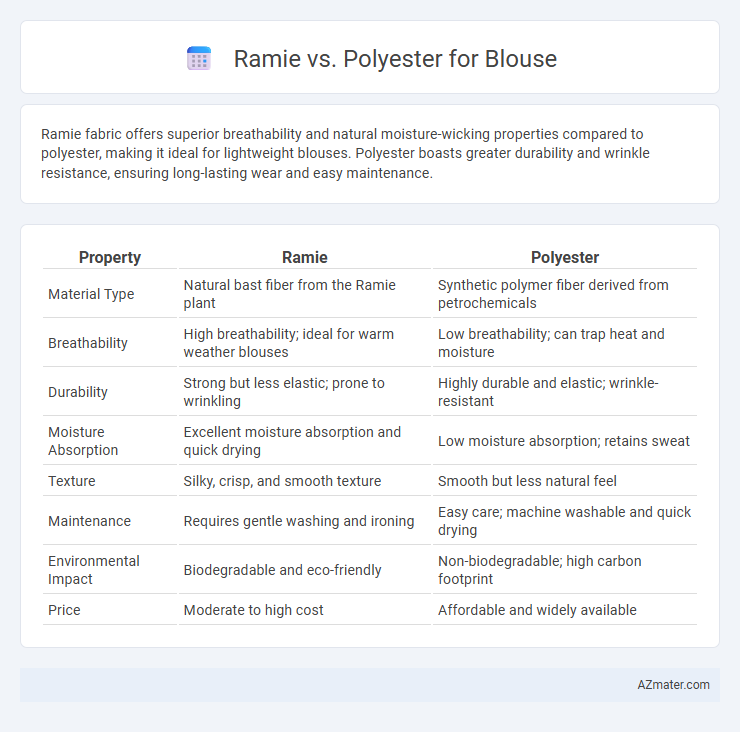Ramie fabric offers superior breathability and natural moisture-wicking properties compared to polyester, making it ideal for lightweight blouses. Polyester boasts greater durability and wrinkle resistance, ensuring long-lasting wear and easy maintenance.
Table of Comparison
| Property | Ramie | Polyester |
|---|---|---|
| Material Type | Natural bast fiber from the Ramie plant | Synthetic polymer fiber derived from petrochemicals |
| Breathability | High breathability; ideal for warm weather blouses | Low breathability; can trap heat and moisture |
| Durability | Strong but less elastic; prone to wrinkling | Highly durable and elastic; wrinkle-resistant |
| Moisture Absorption | Excellent moisture absorption and quick drying | Low moisture absorption; retains sweat |
| Texture | Silky, crisp, and smooth texture | Smooth but less natural feel |
| Maintenance | Requires gentle washing and ironing | Easy care; machine washable and quick drying |
| Environmental Impact | Biodegradable and eco-friendly | Non-biodegradable; high carbon footprint |
| Price | Moderate to high cost | Affordable and widely available |
Introduction to Ramie and Polyester Fabrics
Ramie, a natural fiber derived from the stalks of the Chinese nettle plant, offers a lustrous sheen, high moisture absorption, and excellent breathability, making it ideal for lightweight blouses. Polyester, a synthetic polymer fiber known for its durability, wrinkle resistance, and moisture-wicking properties, provides easy-care and long-lasting performance in blouse fabrics. Choosing between ramie and polyester depends on preferences for natural fiber comfort and eco-friendliness versus synthetic fiber resilience and maintenance convenience.
Key Characteristics of Ramie Blouse Fabric
Ramie blouse fabric stands out for its exceptional breathability and natural luster, making it ideal for warm climates and elegant designs. It offers high moisture absorption and durability, ensuring comfort and longevity compared to synthetic fibers like polyester. Unlike polyester, ramie is biodegradable and hypoallergenic, providing an eco-friendly and skin-friendly option for blouse materials.
Notable Features of Polyester for Blouses
Polyester for blouses offers exceptional durability, wrinkle resistance, and color retention, making it ideal for long-lasting wear and vibrant prints. Its moisture-wicking properties enhance comfort by keeping the wearer dry, while its lightweight nature ensures ease of movement and breathability. Polyester also resists shrinking and stretching, maintaining the blouse's shape and fit over time.
Comfort and Breathability: Ramie vs Polyester
Ramie fabric offers superior breathability and natural moisture-wicking properties, making it highly comfortable for blouse wear in warm climates. Polyester, being synthetic, tends to trap heat and moisture, often resulting in reduced ventilation and less comfort during extended wear. Choosing ramie over polyester enhances airflow and freshness, ideal for maintaining comfort throughout the day.
Durability and Longevity Comparison
Ramie fibers exhibit excellent durability due to their strong cellulose content, making blouses resistant to wear and tear while maintaining breathability and comfort. Polyester, a synthetic fiber, offers superior longevity by resisting shrinking, stretching, and wrinkling, making polyester blouses ideal for frequent use and easy maintenance. In comparison, polyester blouses typically outlast ramie ones in terms of lifespan, but ramie provides a natural, eco-friendly option with reasonable durability for everyday wear.
Maintenance and Care Requirements
Ramie blouses demand delicate care involving hand washing or gentle machine cycles with mild detergents to preserve their natural fibers and prevent shrinkage. Polyester blouses offer superior ease of maintenance, as they are machine washable, wrinkle-resistant, and dry quickly without special treatment. Choosing polyester reduces time spent on ironing and avoids potential damage from exposure to high temperatures or harsh cleaning agents common with ramie fabrics.
Sustainability and Environmental Impact
Ramie is a natural fiber known for its biodegradability and low environmental footprint, requiring minimal pesticides and water compared to conventional crops. Polyester, as a synthetic fiber derived from petroleum, involves energy-intensive production processes and contributes to microplastic pollution in water systems. Choosing ramie for blouses supports sustainable fashion by reducing reliance on fossil fuels and promoting eco-friendly garment lifecycle.
Cost Differences Between Ramie and Polyester Blouses
Ramie blouses typically incur higher costs due to the natural fiber's labor-intensive extraction and limited production compared to polyester, which is a synthetic fabric produced at scale with lower manufacturing expenses. Polyester blouses offer a more affordable option benefiting from mass production efficiencies and lower raw material costs. Buyers seeking budget-friendly blouses often prefer polyester for its cost-effectiveness, while ramie appeals to consumers valuing eco-friendly and breathable fabrics despite the higher price.
Styling and Design Versatility
Ramie offers a natural, textured aesthetic that enhances blouse designs with a breathable and slightly glossy finish, making it ideal for casual and bohemian styles. Polyester provides superior flexibility in styling, with its ability to mimic various fabrics and maintain vibrant colors, allowing for contemporary and structured blouse designs. The choice between ramie and polyester impacts the blouse's drape, sheen, and overall design versatility, catering to different fashion narratives.
Choosing the Right Fabric for Your Blouse Needs
Ramie offers exceptional breathability and natural moisture-wicking properties, making it ideal for lightweight, comfortable blouses in warm weather, while polyester excels in durability, wrinkle resistance, and color retention for long-lasting wear. Choosing the right fabric depends on your priorities: ramie suits those seeking eco-friendly, breathable textiles with a crisp texture, whereas polyester is better for low-maintenance, wrinkle-free blouses that withstand frequent washing. Consider factors like climate, desired blouse feel, and care requirements to select between ramie's natural fibers and polyester's synthetic resilience.

Infographic: Ramie vs Polyester for Blouse
 azmater.com
azmater.com